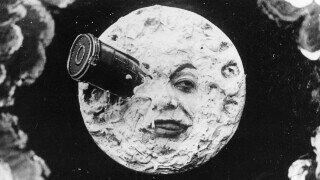How A Jammed Camera Helped Create All Of Science-Fiction

The movie camera was the internet of its day. As in, it was touted as this great technical achievement that would revolutionize science and usher in a new era of progress and enlightenment. But, instead, people almost immediately started using it to make dirty movies and goof around. Georges Méliès was really into the latter (though probably also the former since he was an old-timey French dude and all.)
Born in the mid-19th century, Méliès was an illusionist who wanted to use the camera to film plays and his magic acts. He soon started messing around with tricks like double exposure and the like to try and bring some of his stage magic to the projection screen, which was probably just his sex-stained bedsheet. Hey, like we said, the dude was an old-timey French dude.
Then one day, a weird thing happened. When filming scenes of city life, Méliès’ camera jammed. It took him a few seconds to fix, and when he later developed the film, he noticed that he accidentally invented the jump cut/stop trick. While the camera was malfunctioning, the scenery around the amateur filmmaker continued to change, none of which was being captured on film until Méliès started rolling again. And because the angle and position of the camera didn’t change, the resulting film seemed to show objects disappearing, a man turning into a woman, or a carriage turning into a hearse, etc. It was a total game-changer, like when early internet users discovered that certain combinations of characters could look like stuff, including farting Kirby which, incidentally, looks like this: 8>( > 0_0)>.
Don't Miss
Méliès immediately realized he had stumbled onto something big, and he continued to experiment with other camera tricks until he was ready to put them all into a short film: A Trip to the Moon.
Released in 1902, it was heavily influenced by the writings of Jules Verne and depicted the thing from the title. It also employed “every trick had learned or invented” to create what some consider the first science-fiction movie ever. It was a worldwide hit, and also one of the first internationally pirated movies, really hammering in that comparison from the opening paragraph about the weird similarities between movie cameras and the internet. Great job, us.
And great job, Méliès, since A Trip to the Moon apparently convinced the world that movies could be full of fantastical scenes, flights of imagination, and, eventually, pants-shitting horror. Seriously, watching some of those old-timey movies feels like snorting bath salts off a heavily decomposed clown corpse dressed in your mother’s wedding gown. The point is, Méliès ushered in an era of fantasy and sci-fi movies, which officially ended in 2015 when Mila Kunis said out loud that she wanted to bone the half-human half-dog Channing Tatum in Jupiter Ascending.
Follow Cezary on Twitter.
Top Image: Georges Méliès